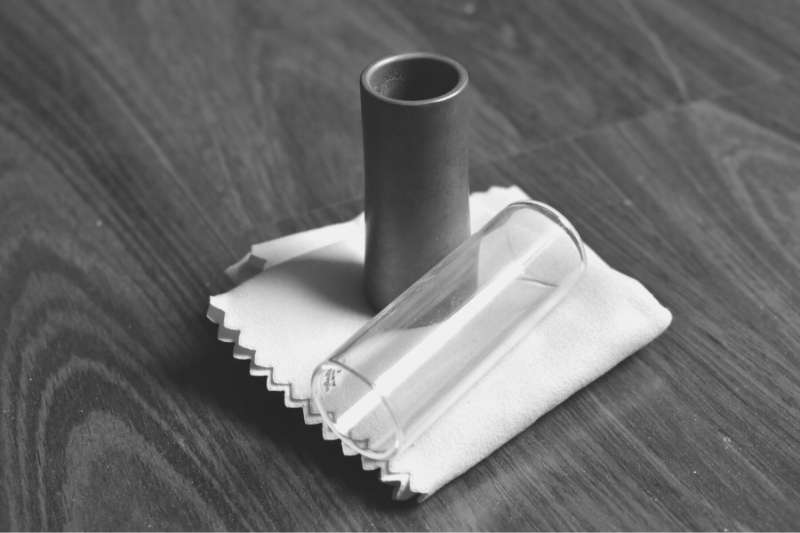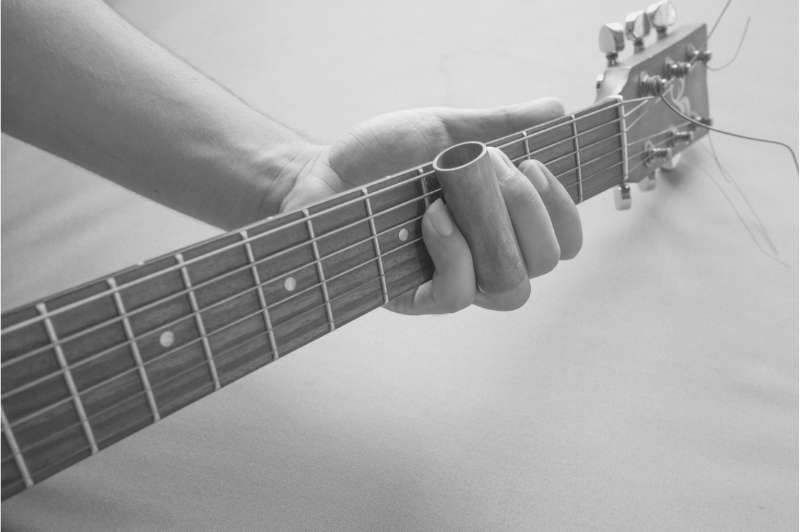If you’re a blues fan, you’ve heard slide guitar. Rock fans may be familiar with the sound, because it makes an appearance in some hard rock songs!
I’ll never forget the first time I heard Led Zeppelin’s In My Time of Dying. Those opening notes are unmistakably different to their usual hard rocking sound.
That was my first introduction to slide guitar and I was kind of hooked!
The good news is that you don’t need a fancy lap steel guitar to play slide guitar. All you need is a guitar slide.
If you’re interested in trying slide guitar, the benefits of a ceramic guitar slide outweigh other types for beginners.
What Does “Slide Guitar” Mean?
Slide guitar is a specific guitar technique. It’s often used by blues and rock guitarists, but it can be found in many other genres.
Old-school slide guitarists used a lap steel guitar, which is designed to lie flat on the knees, or something called a pedal steel. You can see the pedal steel in action below, played by David Gilmour:
But many slide guitarists just lie their regular guitar across their legs to play.
Or, the most modern way to play is just to hold your guitar like normal. Instead of holding chords with your fingers like you would normally, you use a guitar slide.
You’ll either tune your guitar to an open-string tuning so you can play full chords with the slide, or you’ll simply pick the strings instead of strumming.
What Is A Guitar Slide?
A guitar slide is an object you slide up and down guitar strings to change the note. If you’ve ever watched slide guitarists doing their thing, you may have seen them play with some really random things!
Check this out for an idea of just a few of the weird objects you could use as slides:
But if you’re serious about playing slide guitar, it’s best to get yourself a proper guitar slide.
They’re designed in a small tube shape to fit over a finger on your fretting hand, so you can press it against the strings while playing a regular guitar.
What are Guitar Slides Made Of?
The guitar slides you’ll find in music stores are generally made of one of three materials: glass, metal, or ceramic.
Does the guitar slide material matter?
Each one has different pros and cons. Glass slides give a warmer sound, while metal slides are more grungy. Ceramic slides are somewhere in the middle.
Check out this video for a comparison on how different materials affect your guitar’s tone when you’re playing with a guitar slide:
What are the Benefits of a Ceramic Guitar Slide?
If you’re just starting to learn slide guitar, a ceramic slide is a great one to choose as your first guitar slide. Here are a few reasons why:
Balanced Tone
A glass slide has a warmer tone, but it’s more muted. Slides made from metal have a less warm sound, but the tone is bright and loud.
Ceramic slides fall somewhere in between.
So why is this a good thing?
It means they have a fairly warm sound, but it’s not as harsh as a metal slide.
Usually, a ceramic slide also has a glaze on it. Depending on the thickness of the glazing, the tone may be brighter or more muted.
Medium Sustain
Ceramic has a medium sustain, compared to glass (shorter) and metal (longer).
Sustain is the amount of time the note rings out for when you play it; or, how long the string vibrates for when you pluck it.
Usually, this is perfectly okay for most guitarists.
There are other ways of increasing your sustain, like investing in a pedal or audio interface. You can get a great audio interface under 500 dollars if you need something to control your sustain more specifically.
But the medium sustain on a ceramic guitar slide is just right for most guitarists, even if you don’t have other equipment.

Easy to Control
Metal slides can be heavy on the finger and harder to move around the fretboard. Glass slides are much lighter. Ceramic is similar to glass in weight, but provides a bit more punch to your sound.
Why is the weight important when the slide is so small?
Moving from fret to fret is simple and natural with a lighter slide on your finger. It’s easier to stop at the right place too.
Although it takes some time to get used to having a tube on your finger while playing, once you’ve got the hang of it you’ll hardly feel the ceramic slide on your finger.
The material is also porous and absorbs sweat better than other types of slides. This helps keep the slide in place when you’re playing.
There’s nothing worse than your slide flying off your finger mid-solo because your hands are sweaty 🙂
Good for Beginner Slide Guitarists
Whether you’re playing guitars for worship, learning how to play the blues, or just learning how to tune your guitar, a ceramic slide is recommended for beginners.
It’s easy on the fingers, more so than metal and similar to glass. The tone you’ll get with a ceramic guitar slide is warm and well-rounded, and it’s light enough to feel comfortable wearing even while you play.
Once you’re used to playing with a ceramic guitar slide, you can always experiment with others to find the perfect sound for you. But ceramic is the middle ground!

Are There Disadvantages to a Ceramic Guitar Slide?
I do recommend choosing a ceramic guitar slide over others, for all the reasons mentioned above. But there are some disadvantages you need to be aware of.
They’re Fragile
If you drop a ceramic guitar slide, it will probably shatter into pieces. But, just like a guitar tuner or a microphone, you’re not likely to just drop a pricey, important piece of your musical equipment!
A metal slide is the most durable, but ceramic is just about the same as glass. Don’t drop it or bump it, and you’ll be fine!
Harder to Find
In some areas, finding a ceramic guitar slide is just as easy as finding a metal or glass one. In other places, though, getting your hands on a ceramic slide may be difficult. You can always buy one online, but not everybody will have that option.
It’s also generally easier to find a small glass jar, plastic tube, or metal tubing lying around the house, rather than a ceramic tube.
Duane Allman used a Coricidin bottle. Chris Rea started with one of his sister’s nail polish bottles! My first guitar slide was a piece of stainless steel piping.
In fact, many well-known slide guitarists began with a broken-off bottleneck (filed down to avoid losing a finger, of course.)
Ceramic slides are a newer invention, so they’re not as readily available and not likely to be found around the house!
It’s Hard to Find Your Ideal Slide
The biggest downside to a ceramic slide is that you can never tell what ceramic mixture and glazing type you’re getting.
One ceramic slide could be soft and smooth, while another may be gritty and hard. The glazing could be paper thin, or much thicker.
Why could this be a problem?
It means it can be hard to find a ceramic slide that offers your ideal tone without playing around with it quite a bit first.
But the differences in tone and playability are slight. If you’re just starting off, you most likely won’t notice the changes in tone. You may notice that sliding it along the frets is a little more difficult than with the smoothness of glass or steel.

Conclusion
Bottom line? The benefits of a ceramic guitar slide far outweigh the disadvantages! If you’re in the market for a slide, I recommend choosing a ceramic one.
They may be a little harder to find, but it’s worth the search. Guitarists who are serious about learning slide guitar will find a happy medium in a ceramic slide.
It’s warm, round, and the glaze is softer on the finger. If you really don’t want a ceramic guitar slide, I’d say go for glass.
But ceramic would be my first (and last) choice.
Thanks for reading!

